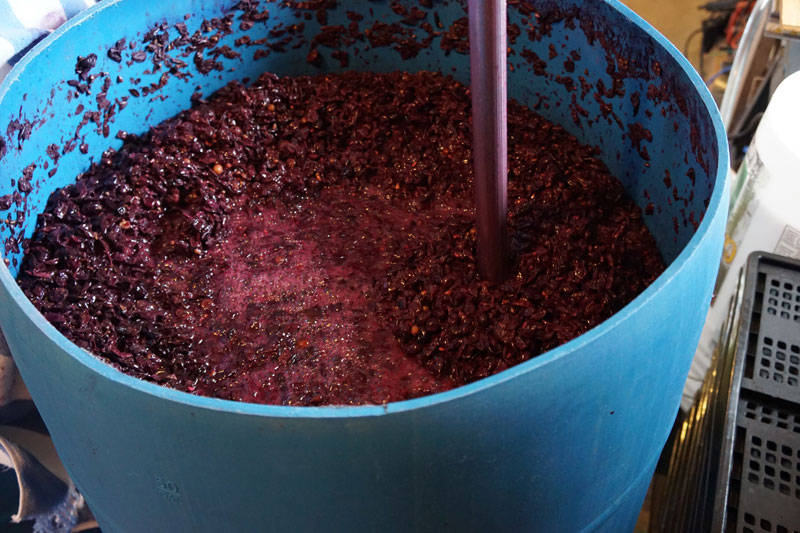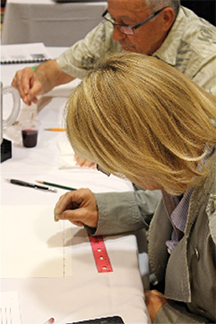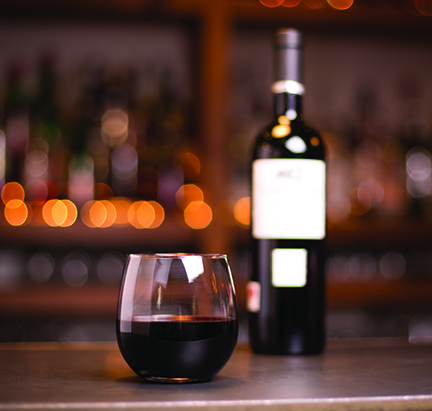Wine is a natural alcoholic beverage that has accompanied mankind from the dawn of history. It has been called “the nectar of the gods,” however, it does not require a miracle but only human intervention to avoid turning to vinegar, the original outcome of naturally fermented grapes. The resulting wine quality is in fact determined by many elements including the grape variety and ripeness, but it is the winemaking process that shapes the microbial metabolism and has the most profound effects. Saccharomyces cerevisiae is the yeast that is primarily responsible for wine’s alcoholic fermentation, thanks to a combination of several “enological” traits: Rapid and complete sugar consumption, ethanol production, transformation of aromatic precursors, as well as its tolerance to initial and final harsh conditions. The use of a selected S. cerevisiae starter culture in the so-called inoculated fermentation has become a common oenological practice to ensure a fast and complete fermentation and reduce the risk of deterioration in wine quality.
Alongside it, many other yeast species are found in wine fermentation. Their environmental habitat are the berries or the cellar equipment surfaces before they are carried over to the must during crushing of the grapes. They are commonly referred to as non-Saccharomyces yeast, and play multiple roles during fermentation, depending on their ability to grow and metabolic activity. Many non-Saccharomyces may lead to serious wine deterioration and have been classified as spoilage: Brettanomyces bruxellensis for its production of unpleasant aromas, such as ethyl-phenols (“horse sweat” taint); Hanseniaspora uvarum for producing high levels of ethyl acetate and acetic acid (vinegar) before and during initial fermentation steps; and Zygosaccharomyces bailii, which may proliferate in bottled wines producing visible sediments or turbidity. Others instead accompany the ethanol fermentation with the production of hundreds of secondary metabolites like organic acids, higher alcohols, and esters. These may positively impact the winemaking process, maintaining the desirable natural variability of wine, the so-called terroir expression, and highlighting mouthfeel, aroma, and flavor complexity.

In attempts to exploit these advantages, an innovative alternative to common fermentation adding only S. cerevisiae has been proposed, which is referred to as the mixed culture or sequential fermentation. The non-
Saccharomyces yeast should be inoculated first, and 2–3 days later, when the fermentation has reached 4–8% alcohol, a Saccharomyces yeast is inoculated. In this way, non-Saccharomyces yeasts, characterized by a limited sugar consumption can contribute to the chemical and sensory properties of the wine at the beginning of fermentation, before the more competitive Saccharomyces yeasts ensure fermentation completion. This scheme of a sequential inoculation mimics what happens in a wild ferment, bringing the best of the two techniques: The complexity of successful wild fermentation with the safety and technical security of a controlled, alcoholic fermentation with selected strains.
Despite the numerous reports on their positive contribution to aroma and flavor diversity, only a handful of non-Saccharomyces species have made it to the market and are starting to be widely adopted for wine production: Torulaspora delbrueckii, Metschnikowia pulcherrima, Lachancea thermotolerans, and to a lesser extent Schizosaccharomyces pombe and Pichia kluyveri. Let’s take a closer look at each:
Torulaspora delbrueckii
T. delbrueckii improves fermentation quality parameters such as wine complexity and aromatic spectrum thanks to specific fruity esters (ß-phenyl ethanol, floral notes), while its powerful ß-lyase activity boosts varietal characteristics (terpenes and thiols). Also, the mouthfeel is positively influenced thanks to a higher release of mannoproteins. Based on these traits, the strain is particularly suited for Chardonnay, Chenin Blanc, Sauvignon Blanc, Pinot Noir, Merlot, and Cabernet Franc. But it stands out for the fermentation of Sauvignon Blanc. The first commercial T. delbrueckii strains that entered the active dry yeast market are Prelude (Chr. Hansen), Biodiva (Lallemand), Zymaflore® Alpha (Laffort), Vinifer NS TD (Agrovin), Levulia Torula (AEB) and EnartisFerm QTau (Enartis).
Metschnikowia pulcherrima
Bioprotection is one of the new alternative methods to reduce the use of sulfur, a major challenge for the wine industry. This method consists in adding microorganisms on grape must before fermentation to limit indigenous spoilage populations of fungi and bacteria. M. pulcherrima can be used as one of these biological control agents thanks to its ability to produce a natural compound, namely pulcherrimin. This insoluble red pigment has antimicrobial activity, binding and depleting iron in the medium through precipitation. Metschnikowia pulcherrima strain is inoculated on the grapes after picking, effectively limiting the growth of spoilage microbiota and protecting must from oxygen, followed by S. cerevisiae when the winemaking process is ready to start.
M. pulcherrima could also help with another challenge for grapes grown in warmer climates; the undesirably high ethanol levels in wines. Delayed sequential inoculation of S. cerevisiae, in which M. pulcherrima is left fermenting for a couple of days, has shown a promising reduction in final ethanol concentration by 0.7–1.6% and high extracellular enzyme production.
The strains commercially available are Primaflora and Levulia pulcherrima (AEB), Flavia and Gaia* (Lallemand), Zymaflore® Egide (Laffort), Excellence B-Nature (Lamothe -Abiet), and AWRI Obsession (Maurivin).
*Metschnikowia frutticola
Lachancea thermotolerans
Driven by climate change the grape ripening is accelerated and grape must is becoming characterized by higher sugar content, higher pH, and lower acidity, if grapes are not perfectly timed for harvest. Consequently, wines often contain overly high ethanol levels but lack acidity. Winemakers can fix these inadequacies through external inputs at the cost of quality. To reduce the detrimental effects for wine of these interventions, it is possible to use a yeast with acidifying and lower-ethanol yielding potential: L. thermotolerans. Its hallmark is the L-lactic acid production (from 1.8 to 12 g/L) from sugars, alongside alcoholic fermentation, thanks to lactic acid dehydrogenase enzyme (LDH). Sequential fermentation results in 0.3–0.5 pH units lower, higher TA (titratable acidity), and about 0.6–1% v/v lower ethanol concentrations.
Commercially available Lachancea thermotolerans are Laktia (Lallemand), Concerto (Chr. Hansen), Octave (Chr. Hansen), EnartisFerm QK (Enartis), Excellence X’Fresh (Lamothe-Abiet), and LEVULIA Alcomeno (AEB).
Schizosaccharomyces pombe
Schizosaccharomyces yeasts can be used to solve the opposite problems encountered in the wine industry: High malic acid content. S. pombe yeast is a good alternative to chemical deacidification or malolactic fermentation when the conditions are too harsh for the bacteria. The yeast is added to the juice at the beginning of the alcoholic fermentation and thanks to its malic dehydrogenase activity, converts malic acid to ethanol and CO2 (malo-alcoholic fermentation) alongside alcoholic fermentation. Although Schizosaccharomyces have shown to possess the ability to finish fermentation and improve wine quality by its own, a sequential inoculum of S. cerevisiae is preferred. The only commercial strain of Schizosaccharomyces pombe currently available is the encapsulated yeast PROMALIC (Proenol).
Pichia kluyveri
P. kluyveri stands out mainly due to its contribution to wine aroma and mouthfeel. The metabolism increases volatile molecules such as esters and varietal thiols, which have potent fruity notes, described as passion fruit and tropical in whites, while in reds are perceived as red fruit and blackcurrant aroma. Since P. kluyveri is unable to ferment fructose, it is recommended to pair it with a fructophilic S. cerevisiae in order to avoid sluggish fermentation. P. kluyveri is particularly suitable for white and rosé wines, and FROOTZEN (Chr. Hansen) is the only strain available in the form of active frozen yeast.
Conclusion
Traditionally, non-Saccharomyces yeasts have been considered as contaminants in many winemaking circles, but this classification has been revisited in recent years. Not only do certain species appear to be a valuable tool to optimize wine quality, they can also bring a distinctive touch to wines compared to that of only a S. cerevisiae fermentation. While these strains are found naturally occurring, inoculating in a controlled and sequential manner can maximize the attributes. These yeasts also contain great potential to mitigate effects of climate change on the quality of wine. Non-Saccharomyces will help winemakers more and more in the years to come to differentiate their production from another’s with increased creative options.
Resources
- Benito, S. (2018). The impact of Torulaspora delbrueckii yeast in winemaking. Applied Microbiology and Biotechnology.
- Benito S. (2019) The impacts of Schizosaccharomyces on winemaking. Appl Microbiol Biotechnol.
- Hranilovic, A., et. al (2017). Chemical and sensory profiling of Shiraz wines co-fermented with commercial non-Saccharomyces inocula. Australian Journal of Grape and Wine Research.
- Hranilovic, A., et al. (2020) Lower-alcohol wines produced by Metschnikowia pulcherrima and Saccharomyces cerevisiae co-fermentations: The effect of sequential inoculation timing.” International Journal of Food Microbiology.
- Hranilovic, A., et al. (2021). Impact of Lachancea thermotolerans on chemical composition and sensory profiles of Merlot wines. Food Chemistry.
- Simonin, Scott, et al. (2020) Bio-protection as an alternative to sulphites: impact on chemical and microbial characteristics of red wines. Frontiers in microbiology.
- Vejarano, Ricardo, and Angie Gil-Calderón (2021) Commercially available non-Saccharomyces yeasts for winemaking: Current market, advantages over Saccharomyces, biocompatibility, and safety. Fermentation.







